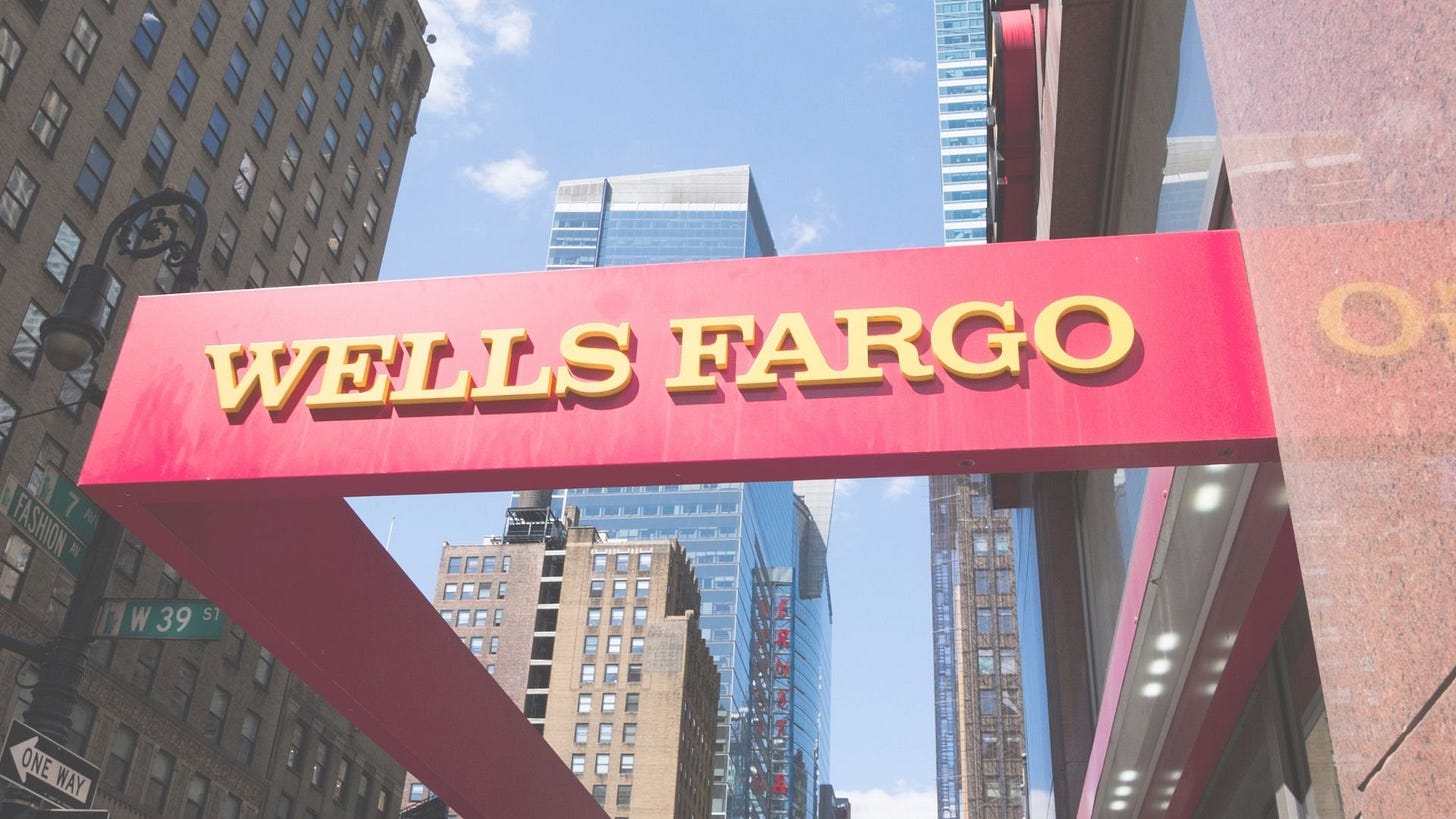The top five climate risk stories this week
1) Wells Fargo sets portfolio emissions targets

Wells Fargo published 2030 portfolio emissions targets on Wednesday, the last of the major Wall Street banks to do so.
The San Francisco-based lender set targets for two sectors: oil and gas and power. It intends to cut absolute emissions in its oil and gas portfolio by 26% and the emissions intensity of its power portfolio by 60%, both relative to a 2019 baseline. The targets cover both direct lending as well as the bank’s capital markets activities.
Wells Fargo used climate scenarios developed by the Network for Greening the Financial System (NGFS) — the club of climate-focused central banks and supervisors — to benchmark its targets. In contrast, Bank of America, Citi, JP Morgan, and Morgan Stanley opted for scenarios developed by the International Energy Agency (IEA), while Goldman Sachs used scenarios it developed internally.
Wells Fargo’s choice of an absolute emissions target for its oil and gas exposures stands out, as of the other big US banks, only Citi has set a similar target. However, Citi’s target only covers committed credit exposures, not capital markets activities.
Wells Fargo’s power target is somewhat less ambitious than some of its peers. Bank of America, Citi, and JP Morgan are all targeting deeper cuts in emissions intensity — measured in kilograms of CO2 equivalent per megawatt hour — and the upper end of Goldman Sachs’ target range is also more ambitious. Again though, of these banks only JP Morgan and Goldman Sachs include capital markets activities in scope of their targets.
To achieve its decarbonization goals, Wells Fargo says it will engage with clients and help them finance decarbonization technologies. The bank plans to set emissions reduction targets for other sectors in the future.
European bank BNP Paribas also published portfolio emissions targets this week. On Tuesday, it announced it would cut the emissions intensity of its power generation, upstream oil and gas and refining, and automotive exposures by 30%, 10%, and 25% by 2025 relative to a 2020 baseline. The targets are benchmarked to the IEA’s Net Zero Emissions 2050 scenario.
The bank also promised to cut its overall credit exposure to the upstream oil and gas industry by 12% by 2025.
2) EBA wary of climate risk weight adjustments

Targeted enhancements to the European Union’s bank capital framework could help shield lenders from climate-related risks better than “green supporting” or “brown penalizing” factors, a discussion paper released by the European Banking Authority (EBA) says.
Published Monday, the paper focuses on the current makeup of Pillar 1 rules — which set the minimum loss-absorbing capital requirements for all lenders — and their ability to capture credit, market, and operational risks from climate change. It also asks questions on whether and how forward-looking calculation methodologies, like climate scenario analysis, could be integrated in banks’ risk measurement approaches.
The EBA says the existing Pillar 1 rules include “mechanisms that allow the inclusion of new types of risk drivers”, including climate-related ones. For example, the rules already set out how banks should use internal risk models, external credit ratings, and up-to-date valuations of collateral and financial instruments when sizing their capital requirements. These could be tweaked to ensure capital requirements better capture climate risks. For instance, the underlying formulae banks use to produce exposure risk weights with their internal models could be adjusted to address environmental risks.
The EBA also assessed whether adjustments to the risk weight of exposures based on how green or carbon-intensive they are should be considered. Risk weights are applied to bank exposures under EU rules to calculate their minimum capital requirements. The watchdog said that initial analysis shows that these so-called “green supporting” and/or “brown penalizing” factors are inferior to “targeted amendments to the existing prudential requirements” when it comes to addressing climate risks.
The EBA welcomes comments on the discussion paper until August 2.
3) Shareholders knock UK banks’ climate plans

UK lenders Barclays and Standard Chartered faced significant investor opposition to their decarbonization strategies in key votes at their annual general meetings (AGM).
Barclays, the UK’s largest financier of fossil fuels according to the Rainforest Action Network, saw 19.19% of shareholders vote against its management’s climate strategyon Wednesday. Nonprofit group ShareAction says the strategy lacks ambition, as it allows for the continued financing of oil and gas expansion and in certain cases permits ongoing support for coal developments.
Investors in Standard Chartered also rebelled against the bank’s climate plan at its Wednesday AGM. Almost 17% of shareholders rejected management’s climate plan, which nonprofit groups say allows it to continue financing fossil fuels in a manner inconsistent with its stated net zero emissions commitment. Analysis by climate advocacy group Market Forces shows that Standard Chartered’s current climate policies only cover about half of its fossil fuel financing, as they exclude debt and equity underwriting.
In addition, around 12% of investors backed a resolution filed by Market Forcesdemanding the bank align its financing activities with a credible net zero pathway.
“Standard Chartered’s institutional investors have some serious questions to answer about their commitment to climate action,” said Adam McGibbon, UK Campaign Lead at Market Forces. “The bank’s climate policies have failed to prevent financing for some of the world’s biggest polluters, and shareholders are allowing themselves to be misled by the bank’s claims to ‘align’ with the IEA’s Net Zero by 2050 scenario.”
4) Net-zero asset owners embrace sectoral decarbonization pathways

New sector-specific net-zero pathways may help asset owners better align their investments with the latest climate science.
Published Wednesday by the Institute for Sustainable Futures (ISF) at the University of Technology Sydney, the 12 sector pathways are already being used by members of the UN-backed Net-Zero Asset Owner Alliance (NZAOA) to inform their target-setting protocol and reporting framework.
The sectors covered are: aluminum; chemicals; cement; steel; textiles and leather; power utilities; gas utilities; agriculture; forestry; aviation and shipping; road transport; and real estate and buildings.
The pathways are based on the One Earth Climate Model (OECM) developed by the ISF, which shows how a 1.5°C global warming target can be achieved. The model provides detailed carbon budgets for the 12 sectors based on a global carbon budget of 400 gigatonnes, which is aligned with what the Intergovernmental Panel on Climate Change (IPCC) says is the limit if global warming is to be kept to 1.5°C by 2050 with 67% certainty. The OECM data is open source, allowing users to understand the assumptions underlying the sectoral carbon budgets.
“For asset owners committed to net zero portfolio alignment sector pathway information is of utmost importance for investment portfolio steering,” said Günther Thallinger, Chair of the NZAOA. “Asset owners’ investee companies are assessed against these pathways. Furthermore the OECM pathways need to be the basis for discussions with policy makers on the development of industry sectors.”
5) BoE’s systemic risk unit focused on climate change

Central banks and supervisors have a responsibility to help “build resilience to climate-related financial risks” and support the low-carbon transition, an official on the Bank of England’s (BoE) committee for tackling systemic risks has said.
In a speech on Tuesday, Elisabeth Stheeman — an external member of the 13-strong Financial Policy Committee (FPC) — said the group is “well-placed” to tackle climate risks as these have similar characteristics to the other financial stability risks the FPC addresses. Specifically, climate risks are systemic, non-linear, and foreseeable — if also uncertain.
“It is … clear that climate change and the transition to net zero have economic and financial consequences that are relevant to the FPC’s responsibility to monitor systemic risks. As the challenge has become clearer, so has the Bank’s particular role in responding to it,” said Stheeman.
She added that the FPC will be analyzing the results of the BoE’s inaugural climate risk stress test of banks and insurers to understand “the extent of the exposures in the financial system to climate-related risks.” The Bank says the results of the stress testwill be published on May 24.
The FPC was set up by the BoE after the global financial crisis with a mandate to identify, monitor, and take action to eliminate or limit systemic risks to the UK financial system.

